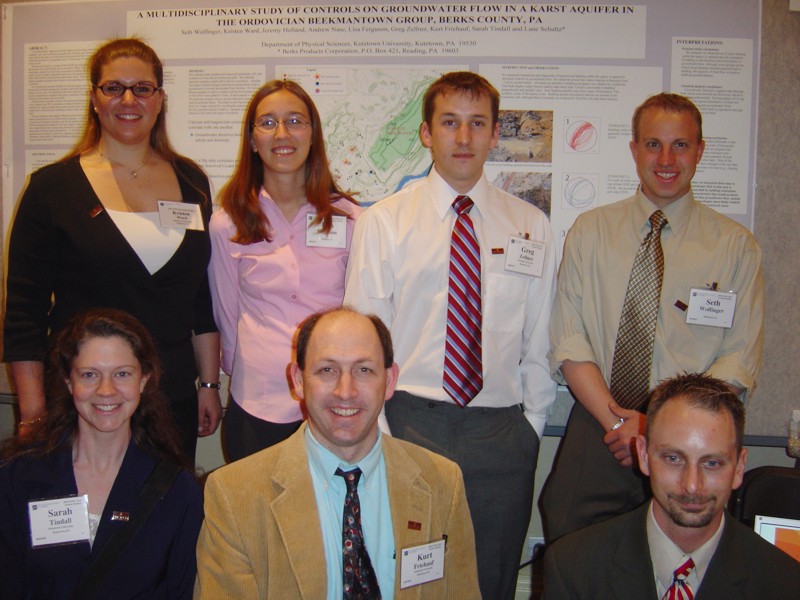
 A
Multidisciplinary Study of Controls on Ground-Water Flow in a
Karst Aquifer in the Ordovician Beekmantown Group, Berks County,
PA
A
Multidisciplinary Study of Controls on Ground-Water Flow in a
Karst Aquifer in the Ordovician Beekmantown Group, Berks County,
PA
Wolfinger,
Seth, Ward, Kristen, Holland, Jeremy, Nase, Andrew, Ferguson,
Lisa, Zellner, Greg, Friehauf, Kurt, Tindall, Sarah,
and Schultz, Lane, 2004, A
Multidisciplinary Study of Controls on Ground-Water Flow in a
Karst Aquifer in the Ordovician Beekmantown Group, Berks County,
PA [abs]: Geological Society of America Northeastern Section
(39th Annual) and Southeastern Section (53rd Annual) Joint Meeting
(March 25-27, 2004) Geological Society of America Abstracts with
Programs, vol. 36, no. 2, p. 128.
 A multidisciplinary approach has been
employed that includes detailed fracture mapping, water table
monitoring, ground-water chemistry and lithogeochemistry to study
factors that affect cave formation and ground-water flow through
Ordovician carbonates proximal to an aggregate quarry in Ontelaunee
Township, Berks County, Pennsylvania.
A multidisciplinary approach has been
employed that includes detailed fracture mapping, water table
monitoring, ground-water chemistry and lithogeochemistry to study
factors that affect cave formation and ground-water flow through
Ordovician carbonates proximal to an aggregate quarry in Ontelaunee
Township, Berks County, Pennsylvania.
Bedding in the quarry is oriented S38W-60NW and sedimentary
structures demonstrate the rocks in the pit are not isoclinally
folded. Clay- and boulder-filled dissolution conduits up to 5m wide
exist parallel to bedding and are exposed in the south wall of the
quarry; dissolution features are also prominent within a 10m wide,
S80E-68SW fracture zone near the southwestern corner. Dissolution is
apparent in bedding-parallel carbonate veins, whereas veins
perpendicular to bedding are less weathered.
Ten synchronized pressure transducers with data loggers installed in
a 1-km2 monitoring well field continuously recorded water table
fluctuations and temperature during a storm event. By identifying
water table responses to storms, together with rock fracture
characteristics mapped in the quarry, prediction of dissolution
channel formation in the aquifer may be possible.
Ground-water temperature in each well remained unchanged during the
storm, with values ranging from 18ºC (temperature of adjacent
streams) to 12ºC. The 12ºC end member may represent longer-term
resident ground water and wells with intermediate temperatures
reflect mixing of infiltrating surface waters and cold resident
ground water.
Pressure transducer data suggest different sections of the well
field respond to storm-induced perturbations in one of three
distinct patterns. (1) Wells characterized by a symmetrical
fluctuation coincident with the rise and fall of the regional
ground-water table are interpreted to represent zones in the aquifer
with unrestricted flow. (2) Wells with a rapid initial water level
increase followed by a gradual return to base levels are interpreted
to indicate more restricted flow. (3) Wells characterized by an
initial spike superimposed on pattern (1) may have experienced
initial channel blockage, e.g. clay subsidence, followed by a
clearing of blockage allowing water levels to return rapidly to
regional water table levels.

 A
Multidisciplinary Study of Controls on Ground-Water Flow in a
Karst Aquifer in the Ordovician Beekmantown Group, Berks County,
PA
A
Multidisciplinary Study of Controls on Ground-Water Flow in a
Karst Aquifer in the Ordovician Beekmantown Group, Berks County,
PA 
 A
Multidisciplinary Study of Controls on Ground-Water Flow in a
Karst Aquifer in the Ordovician Beekmantown Group, Berks County,
PA
A
Multidisciplinary Study of Controls on Ground-Water Flow in a
Karst Aquifer in the Ordovician Beekmantown Group, Berks County,
PA  A multidisciplinary approach has been
employed that includes detailed fracture mapping, water table
monitoring, ground-water chemistry and lithogeochemistry to study
factors that affect cave formation and ground-water flow through
Ordovician carbonates proximal to an aggregate quarry in Ontelaunee
Township, Berks County, Pennsylvania.
A multidisciplinary approach has been
employed that includes detailed fracture mapping, water table
monitoring, ground-water chemistry and lithogeochemistry to study
factors that affect cave formation and ground-water flow through
Ordovician carbonates proximal to an aggregate quarry in Ontelaunee
Township, Berks County, Pennsylvania.